The 10 Hardest SAT Writing Questions Ever
Author
Hartwell
Date Published
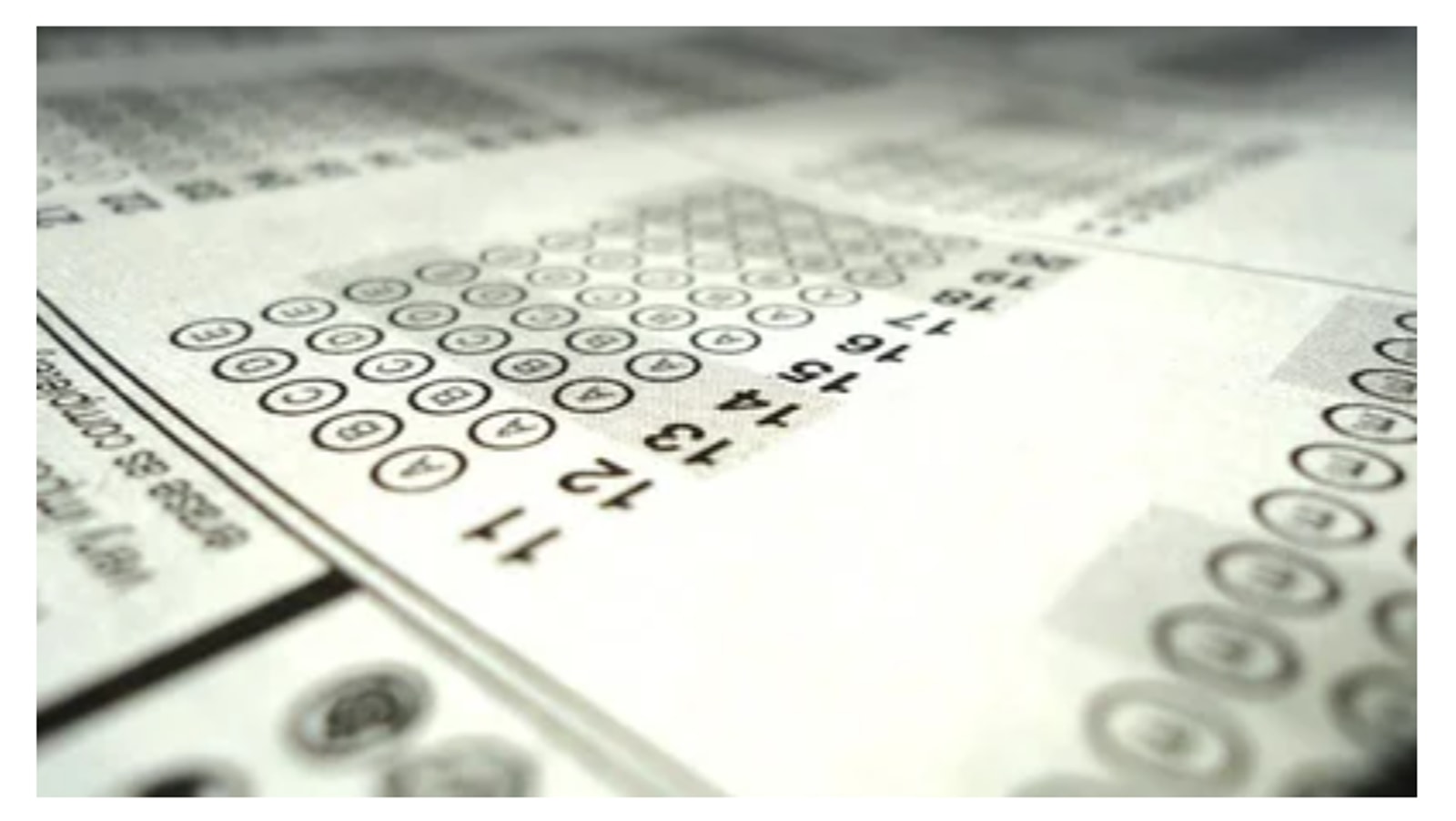
You’ve been working hard, and now it’s time to put your knowledge to the ultimate test! Are you ready to tackle 12 of the most challenging questions found in the digital SAT's Reading and Writing section? I’ve carefully reviewed all the official practice tests to identify the toughest SAT Writing questions. If you manage to get all of these correct, you can confidently call yourself a master of this section.
Why Are the Hardest Questions Important?
Developing strategies for handling tough questions is an essential part of your test preparation. Your target score will guide how you approach these challenges.
This is especially crucial now that the digital SAT combines the Reading and Writing sections into one. If you’re curious about all the updates to the SAT, don’t forget to check out our detailed article that explains the changes.
Aiming for a Score Between 700 and 800?
If your goal is to score between 700 and 800 in Reading and Writing, mastering these types of questions is key to achieving your target. These challenges will help refine your skills and get you closer to that top score.
Aiming for a Score Between 500 and 600?
On the other hand, if your target score falls between 500 and 600, you don’t need to correctly answer every question in this section to achieve your goal. When faced with particularly tricky questions like the ones listed below, it’s completely fine to make an educated guess and move on.
Regardless of your target range, strong study habits are essential for success. Not sure where to start? Check out our guide to preparing for the new digital SAT, and then explore our comprehensive explanation of all the grammar rules tested in the SAT Reading and Writing section.
What Makes a Question "Hard"?
As a quick reminder, the Reading and Writing section of the digital SAT includes multiple-choice questions based on written passages. These questions assess your understanding of grammar, punctuation, effective word choice, and logical writing. For a complete breakdown of SAT Writing grammar rules, see our guide.
While the College Board no longer categorizes questions by difficulty, how can we identify the hardest ones? And what makes these questions so tricky?
Even though the digital SAT avoids including deliberately deceptive questions, it often presents scenarios where multiple answer choices may seem plausible. This happens when a question tests more than one skill simultaneously—like combining a punctuation rule with an understanding of passage logic or pairing a grammar principle with idiom usage. In other cases, questions might require you to address both sentence-level issues and overarching problems across multiple paragraphs.

Spoiler Alert
Before diving into the hardest SAT Reading and Writing questions, here’s a quick spoiler alert.
These questions are taken directly from the official full-length SAT practice tests. If you think you might remember both the questions and their answers after reading this, it’s better to revisit this article after completing all the official practice SATs.
Let’s Get to the Questions!
The questions below cover a range of concepts that the SAT identifies as particularly challenging for students. Keep in mind that all of these questions are based on 25- to 150-word passages, as the entire SAT Reading and Writing section is now passage-based.
Give them a try and see how you perform! For an added challenge, set a timer and limit yourself to 40 seconds per question.
Each question is followed by its correct answer and a detailed explanation.
Question 1
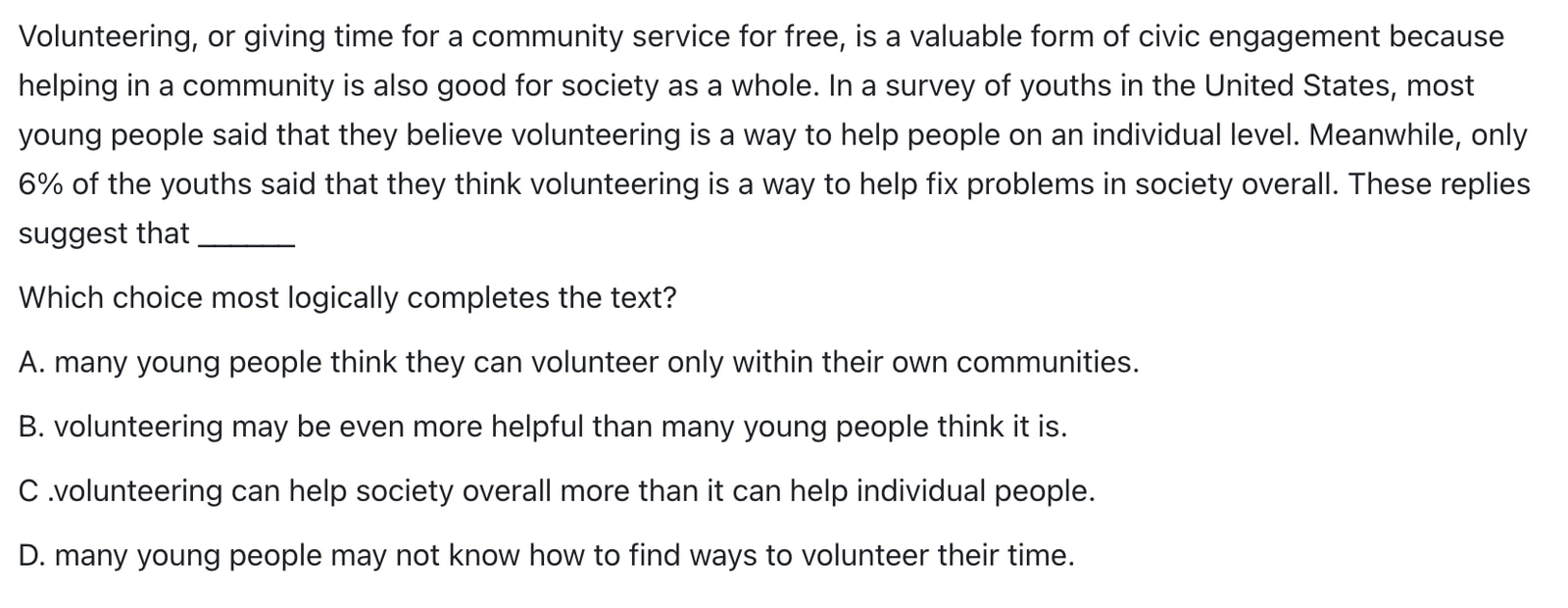
The Challenge
The primary objective of this question is to assess your ability to determine logical paragraph flow. The challenge lies in the fact that two of the answer choices (B and C) appear equally plausible from a logical standpoint.
Answer
B
Explanation
A concluding sentence should logically synthesize and build upon the preceding discussion within a paragraph, using the information presented to advance the central point.
In this specific paragraph, answer choice B is the most appropriate conclusion because it logically completes the discussion about volunteering. Why? The data within the paragraph imply that many young people lack a comprehensive understanding of volunteering’s positive impact on society. This suggests that "volunteering may be even more helpful than many young people think it is" (choice B).
Options A, C, and D are incorrect because they draw conclusions unsupported by the information in the given text. There’s no indication that young people believe they can only volunteer in their local communities (choice A). Likewise, there is no information to suggest that volunteering benefits society more than individuals (choice C) or that young people are unsure of how to volunteer (choice D).
You will frequently encounter this pattern in other SAT Reading and Writing questions that test textual logic. One answer choice will be a logical conclusion based on suggestions made in the text, while the other three choices will attempt to draw conclusions from information not contained in the text.
Question 2
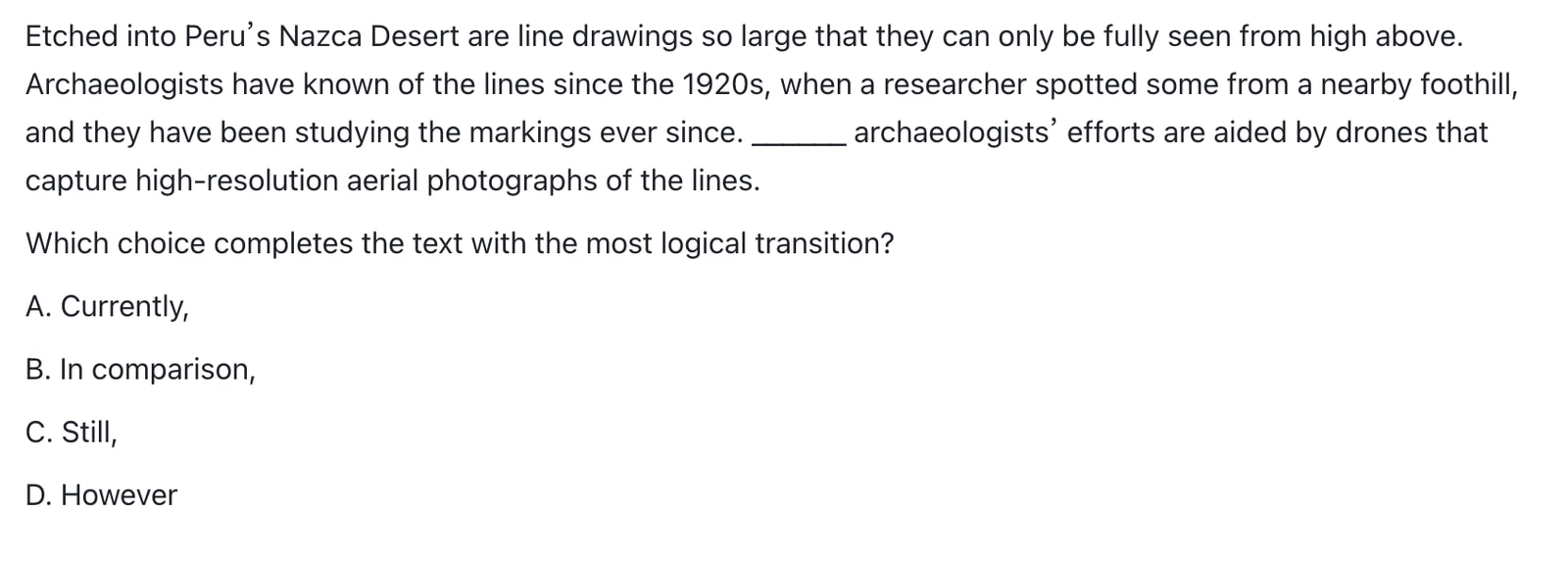
The Challenge
This question focuses on your understanding of transition words. Transitions are crucial for signaling how the information in the current sentence logically connects to the action or idea presented in a previous sentence.
Answer
A
Explanation
A helpful strategy is to temporarily ignore the provided transition and read the two sentences without it. This lets you focus on the core information and determine the best logical connection without being influenced by the choices.
"Currently" (the correct answer, choice A) logically signals that the use of drones for contemporary research builds upon the archaeological research discussed in the previous sentence. The emphasis is on an ongoing, present-day aspect of research.
"In comparison" (choice B) would create an illogical comparison between the current sentence's use of drones for present-day research and the archaeological research mentioned in the preceding sentence. It sets up a comparison where none exists.
"Still" (choice C) incorrectly suggests that the present-day use of drones is happening despite ongoing archaeological research, which doesn't make logical sense. It implies an obstacle.
"However" (choice D) creates an illogical contrast. It suggests that the current use of drones for research is somehow opposed to prior archaeological research, which is not supported by information.
Choices B, C, and D are all incorrect because they fail to convey that the use of drones is a continuation of the established research, representing its present-day implementation. They don't establish a clear present-day connection.
Question 3

The Challenge
This question examines your understanding of subject-modifier placement. It's specifically testing your ability to correctly position a modifier in relation to the noun phrase it describes within a sentence structure.
The difficulty lies in the fact that the subject of the sentence isn't explicitly stated in the passage. You'll need to infer the subject using contextual clues and identify it within the answer choices.
Answer
A
Explanation
Choice A is correct because it correctly identifies "many critics" as the subject of the sentence. Moreover, it positions the subject in the most logical place within the sentence structure, directly following the modifying phrase, "in assessing the films of Japanese director Akira Kurosawa."
Choices B, C, and D are incorrect because they all result in a faulty or dangling modifier. A dangling modifier is a phrase or clause that attempts to modify a word that isn't explicitly present in the sentence. Each of these choices suggests that a subject other than "many critics" is doing the assessment of Kurosawa's films, which is both illogical and grammatically incorrect.
Dangling modifiers are notoriously tricky. If you need more practice on these, consult our guide to faulty modifiers!
Question 4
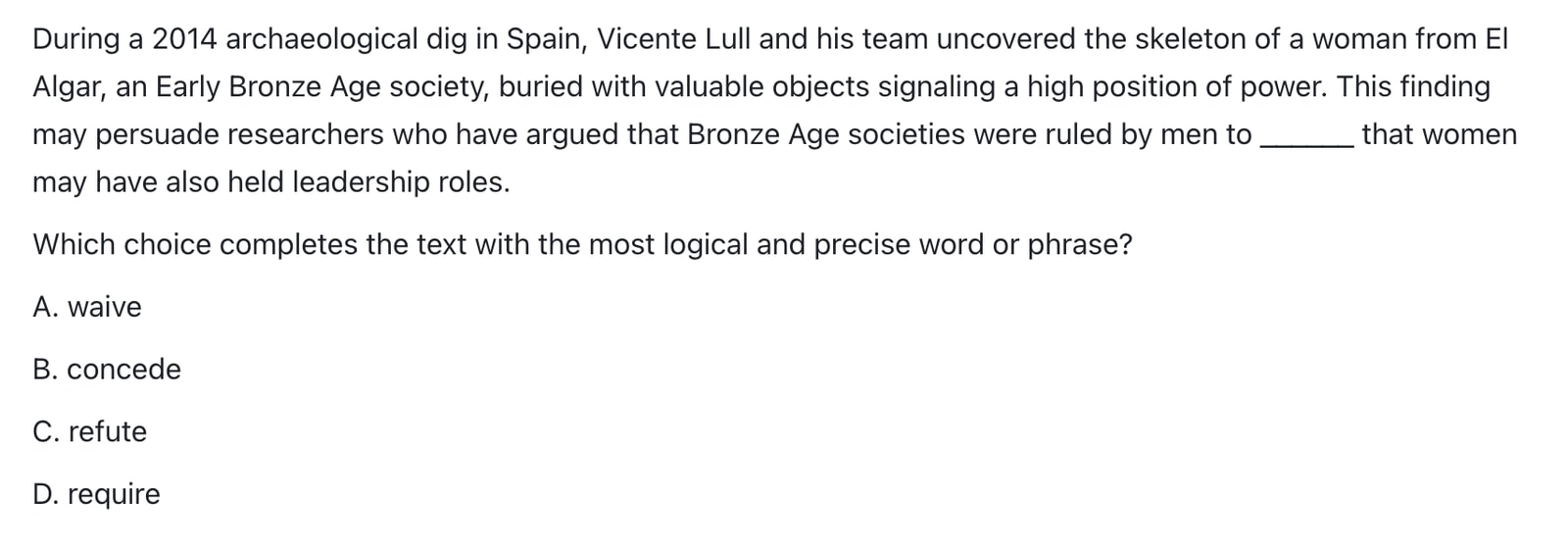
The Challenge
The SAT Reading and Writing section often features "Words and Phrases in Context" questions. This one requires you to select the answer choice that best completes the sentence, logically fitting within the overall discussion of the significance of the 2014 archaeological dig at El Algar.
The challenge lies in the fact that two of the answer choices (B and C) could conceivably fit the sentence on their own, but when viewed in the context of the entire paragraph, only one (B) offers a truly logical completion.
Answer
B
Explanation
Answer B is correct because the meaning of the word "concede" functions logically within the larger context of the passage. In this context, "concede" means to acknowledge a truth after previously denying or disputing it. The text presents evidence that challenges the assumption that Bronze Age societies were exclusively male-dominated. The burial of a woman with valued objects suggests that women may have held positions of power. Therefore, the text hints that researchers holding the male-leadership belief will need to re-evaluate their assumptions.
Both answer choices A ("waive") and D ("require") are incorrect because their meanings do not logically apply to the actions described in this context. They don't fit the intent of the sentence or the point of the paragraph.
Answer choice C ("refute") is illogical. "Refute" means to prove something false. The preceding sentences present evidence that counters the idea that women didn't hold power positions. Therefore, for researchers to refute this evidence in the context of the overall passage makes little sense.
The key to success on "Words and Phrases in Context" questions is to substitute each answer choice into the sentence provided, and then assess its meaning within the framework of the entire passage. Does the choice make sense within the whole passage? If so, it's likely the correct answer.
Question 5

The Challenge
Successfully answering this question requires a firm grasp of how to correctly coordinate main clauses within a sentence, specifically using semicolons.
The specific challenge presented here is the existence of several answer choices that incorrectly separate the main clauses using only a comma. Each answer choice employing a comma in this way would result in a comma splice, a common punctuation error.
Answer
B
Explanation
The provided text contains two main clauses. Main clauses always need to be separated using either:
A period.
A semicolon.
A comma and a coordinating conjunction (and, but, or, nor, for, so, yet).
In this case, no answer choice that uses a comma incorporates a coordinating conjunction. Therefore, answer choice B, which correctly uses a semicolon, is the only grammatically valid option.
Answer choices A, C, and D all produce a comma splice because they separate two main clauses using only a comma, without a coordinating conjunction. Thus, these answer choices are incorrect.

Question 6
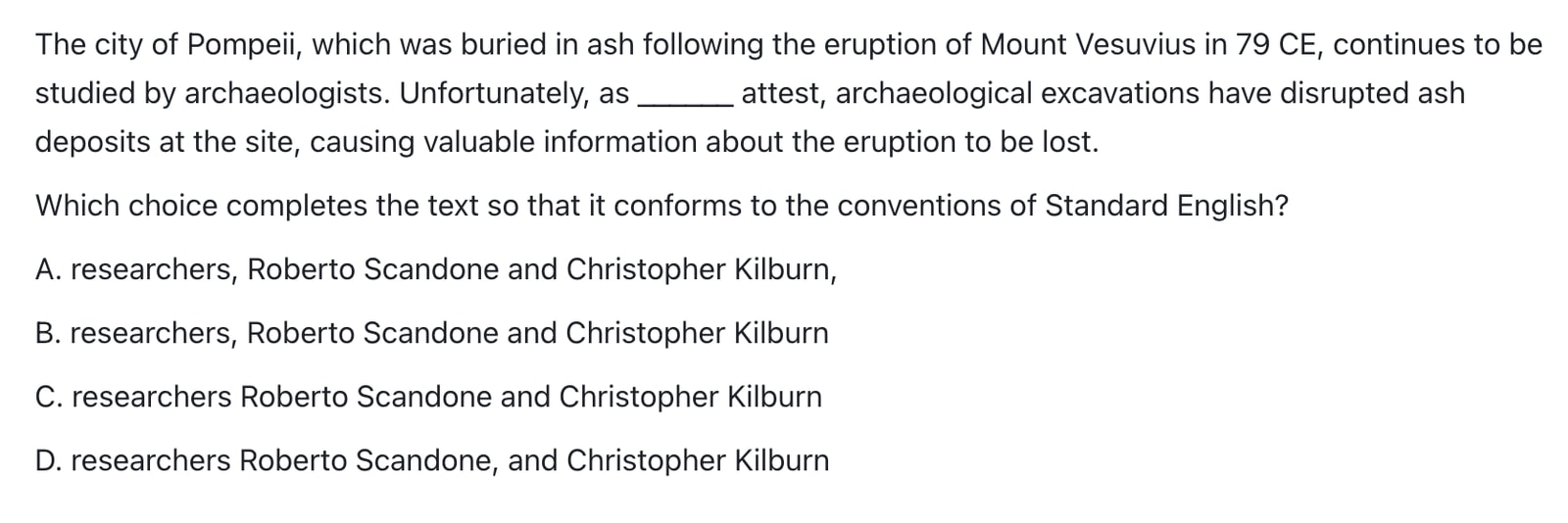
The Challenge
This is a punctuation question designed to assess your understanding of how to punctuate a restrictive coordinated noun phrase.
This question poses a challenge because nonrestrictive clauses (which always use commas) often incorporate proper nouns, and these answer choices also include proper nouns. However, in the context of the sentence, these names form a restrictive phrase, meaning they should not be set off with commas.
Answer
C
Explanation
Answer choice C is the correct answer because no punctuation is needed to separate the coordinated noun phrase "researchers Roberto Scandone and Christopher Kilburn." Using commas here would illogically separate the noun "researchers" from the coordinated phrase, creating a lack of cohesion.
Because answer choices A, B, and D all incorrectly set off the noun phrase using commas, each of these choices is incorrect.
Question 7
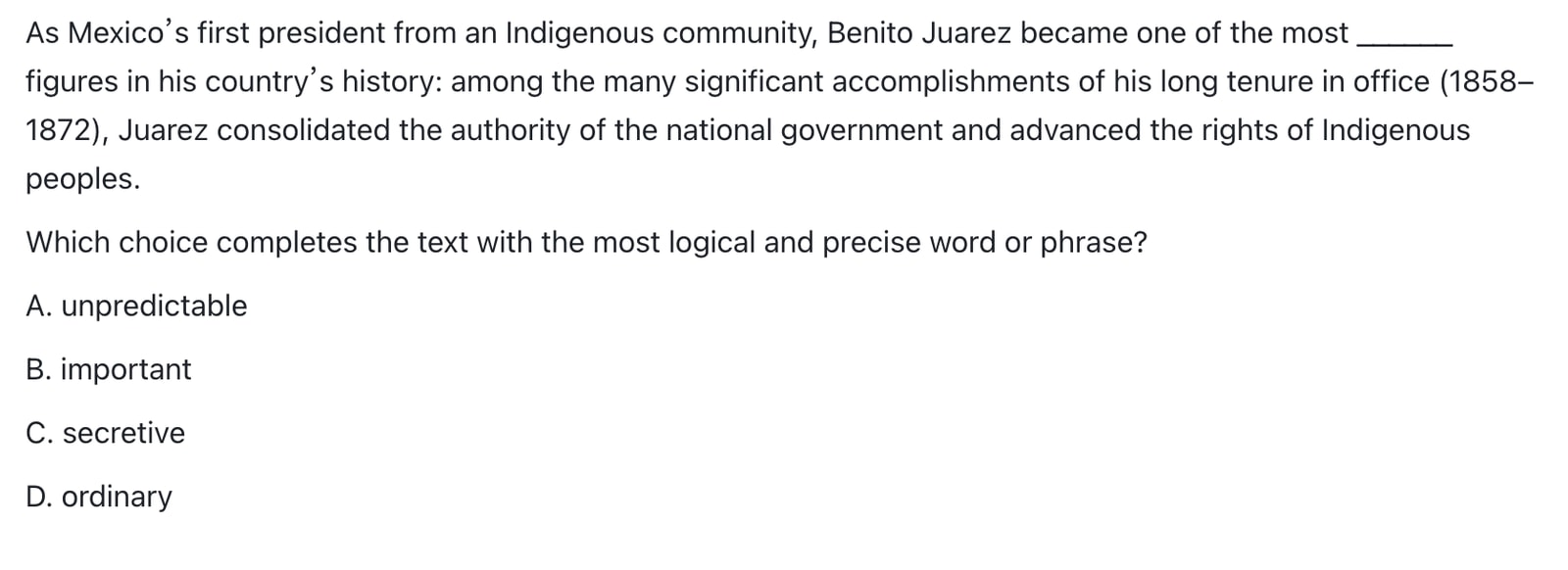
The Challenge
This reading and writing question is designed to assess your ability to select words with precision. The difficulty is that every answer choice is grammatically correct when inserted into the sentence; therefore, you need to read carefully to determine the subtle differences in meaning.
Answer
B
Explanation
To identify the correct answer, you must consider each choice within the context of the entire passage. The description of President Juarez in the text reveals that he achieved significant accomplishments while in office. Consequently, the best answer is "important" (choice B), which means "marked by significant work or consequence," as it aligns directly with his achievements.
"Unpredictable" (choice A) is incorrect because the text provides no evidence that President Juarez acted in a surprising or erratic manner.
Similarly, choices C ("secretive") and D ("ordinary") also contradict the context. The passage does not suggest that President Juarez kept things hidden, and it implies that he was anything but ordinary.
Since choices A, C, and D are not logical and lack the required precision within the context of the passage, they are incorrect choices.
Question 8

The Challenge
This question focuses on verb tense consistency, requiring you to select the correct verb tense to maintain a clear and grammatically correct sentence.
The complexity arises from the fact that multiple answer choices contain present-tense verbs. You must carefully analyze each choice to determine which verb best fits, in relation to the other present-tense verbs in the sentence: "travel" and "are diverted."
Answer
B
Explanation
Answer choice B is correct because the present-tense verb "reach" is consistent with the other present-tense verbs "travel" and "are diverted." The verbs collectively describe a general, recurring pattern of movement for atoms.
Choice A ("will reach") is incorrect because it uses the future tense. Although the behavior might be considered a repeated action, this tense clashes with the present tense already present within the sentence. Therefore, using the future tense here disrupts the sentence’s internal consistency.
Choice C ("had reached") is incorrect because it employs the past perfect tense, which again, is at odds with the other present-tense verbs.
Choice D ("are reaching") employs the present progressive tense. It is illogical when paired with the other simple present tense verbs in this sentence.
Question 9

The Challenge
This question tests your understanding of sentence structure, specifically the use of finite and non-finite verb forms. Furthermore, it requires you to apply this knowledge to a complex sentence.
The challenge is twofold:
The sentence contains a long, complex structure, with a main clause separated by modifying clauses, making it hard to readily identify all the parts and relationships.
You must choose the correct verb form (finite or non-finite) that logically completes the sentence, coordinating with the main clause "those food sources may become unavailable because of extensive snow and ice cover."
Answer
C
Explanation
Understanding Finite vs. Non-Finite Verbs:
Finite verbs show tense, person, and number (e.g., I eat, she eats, they eat).
Non-finite verbs (also called infinitives, participles, etc.) do not show tense, person or number (e.g., to eat, eating). These frequently appear in -ing or -ed forms, or as infinitives (with or without "to").
In subordinate clauses, such as that which is being filled in within this question, non-finite verb forms are the most commonly used. The phrase beginning with the correct verb would typically function as a descriptive phrase, expanding on the main clause's meaning in terms of how this unavailability came to be.
The non-finite present participle "forcing" (choice C) correctly forms a participial phrase, which logically modifies the main clause, so choice C is the correct answer.
The present tense verb "forces" (choice A) and the past tense verb "forced" (choice D) are incorrect because they are finite verbs, and cannot work correctly to supplement the main clause in a grammatical way.
Choice B is a little trickier. "To force" is a non-finite to-infinitive and thus could be used to form a subordinate clause. However, to-infinitives typically present purpose. Because the sentence makes no inference about a situation being established to force the monkey to hunt for food, then choice B is also not the correct answer choice.
Question 10

The Challenge
This question tests your knowledge of plural and possessive nouns. The difficulty stems from the fact that each answer choice presents two nouns, and both must be in the correct form to create a grammatically sound sentence.
Therefore, to answer correctly, you have to be precise with both the plural and the possessive form of each noun, in relation to its meaning within the sentence.
Answer
A
Explanation
To be correct, an answer requires correct use both times. Let's examine the words selected in answer choice A, "people's stories":
The plural possessive "people's" correctly indicates possession by multiple people. The plural noun "stories" indicates there's more than one story. Together, these two selections correctly express that we are discussing multiple stories, each coming from a distinct set of multiple people.
Answer choice B is incorrect because it contains "peoples" (incorrect plural of "people") and "story's" (incorrect singular possessive).
Answer choice C is also incorrect because it has the same plural noun "peoples." In answer choice D, the singular possessive noun "story's" is incorrect because the requirements of the sentence require a plural.

The Bottom Line: Conquering Tricky Reading & Writing Questions
The most challenging questions on the SAT Reading and Writing section often share these characteristics:
Multi-Skill Assessment: They simultaneously test multiple grammar, editing, punctuation, or vocabulary skills.
Plausible Distractors: They feature two or more answer choices that seem equally correct at first glance.
Deceptive Focus: Their answer choices mislead you into thinking they test one concept, while the true test lies in a completely unrelated skill.
To succeed on these difficult questions, consider this multi-step approach:
Independent Analysis
Before looking at the answer choices or the text the question relates to or surrounds, cover them up! This is crucial for avoiding being influenced by the answer choices.
Focus on understanding the context. Read the surrounding text (sentences or paragraphs that aren't in question).
Ask yourself:
What is the main point of this passage/paragraph/sentence?
How do the different parts relate to each other? Is there a logical flow? What is the order of the argument?
If I had to complete the sentence or insert a phrase, what would I select?
Precise Answer Choice Selection
Now, review the answer choices and re-read the original sentences or passages. Find the option that most closely aligns with your independent analysis and original thoughts.
Why is this better? You are not working backward from the answer choices. You are using your reasoning to draw your own conclusion. After this, with your understanding, you can pick the right choice.
Re-read the whole text (both the question and the passage). Does this work in context? Is the original passage of the whole correct or not?
Remember:
By approaching questions with an independently formed understanding of the text, you are less likely to be swayed by the test-makers' attempts to trick you. Good luck!
Related Posts
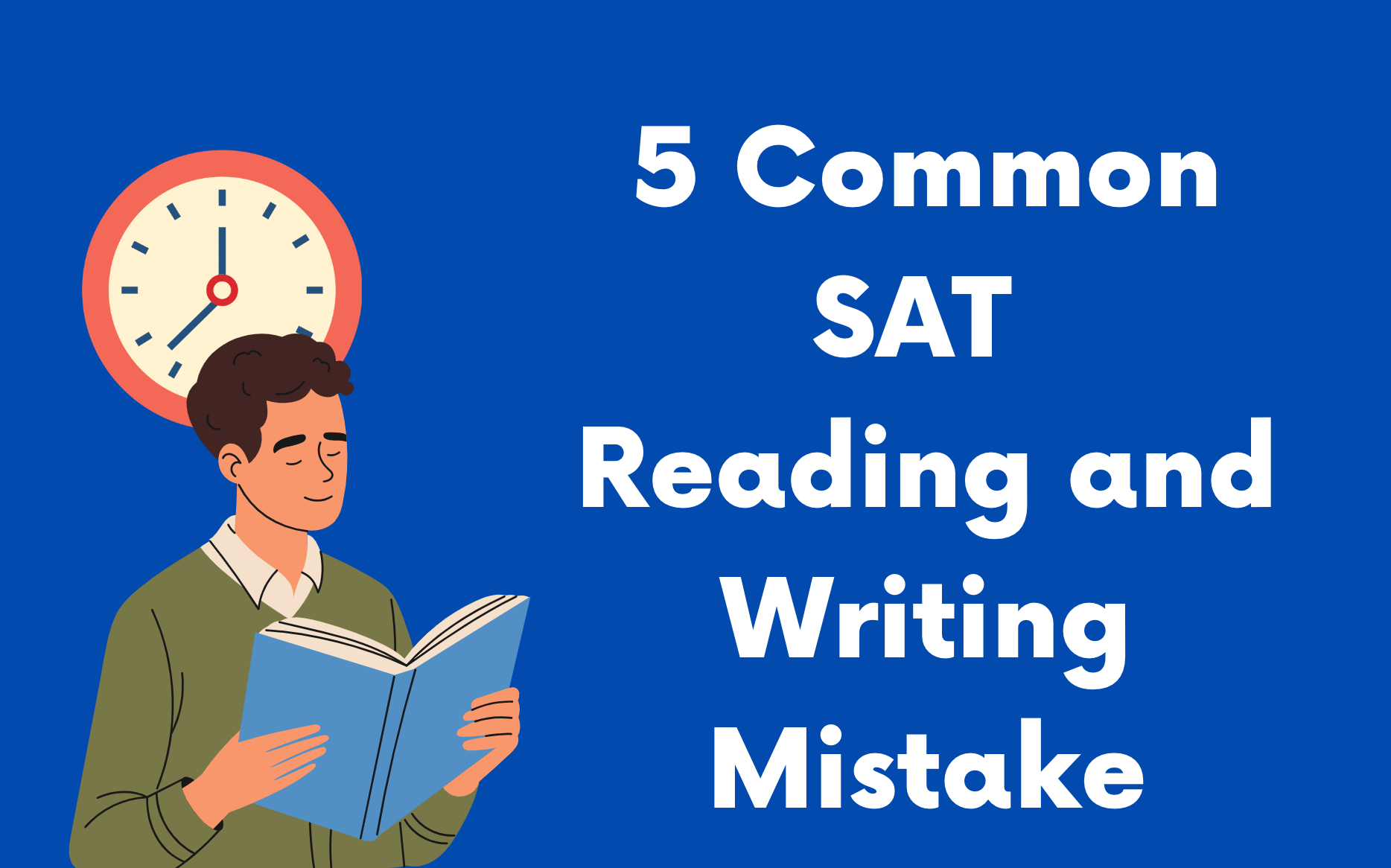
Struggling with the Digital SAT Reading & Writing section? Discover 5 common mistakes students make and actionable tips to boost your score!

Enhance your SAT reading skills with effective strategies and practice for function questions. Boost your confidence and improve your scores!